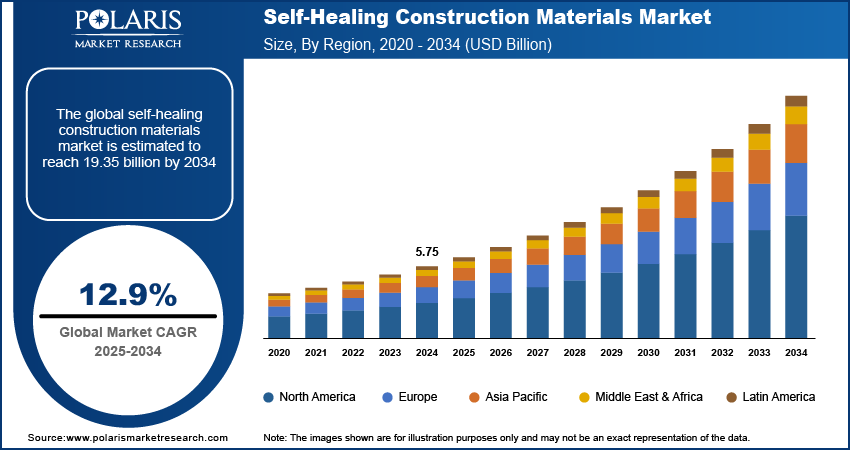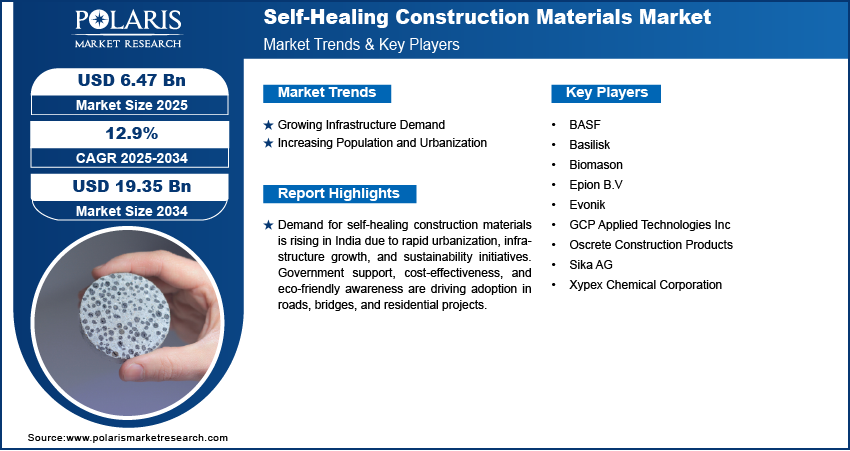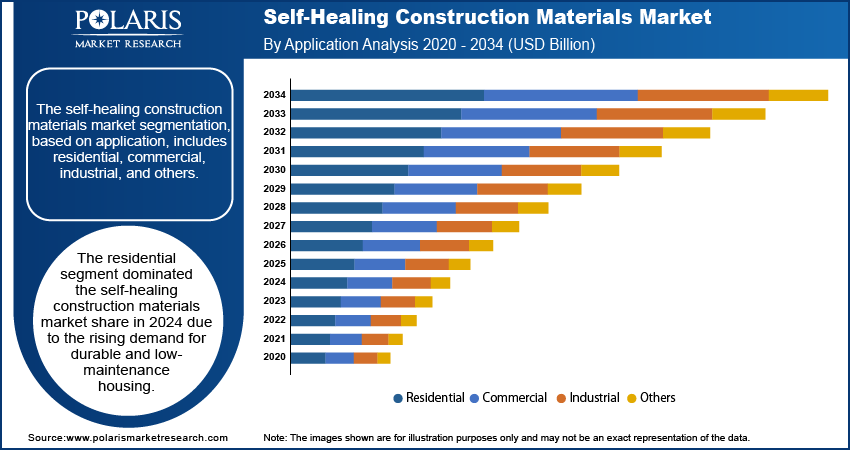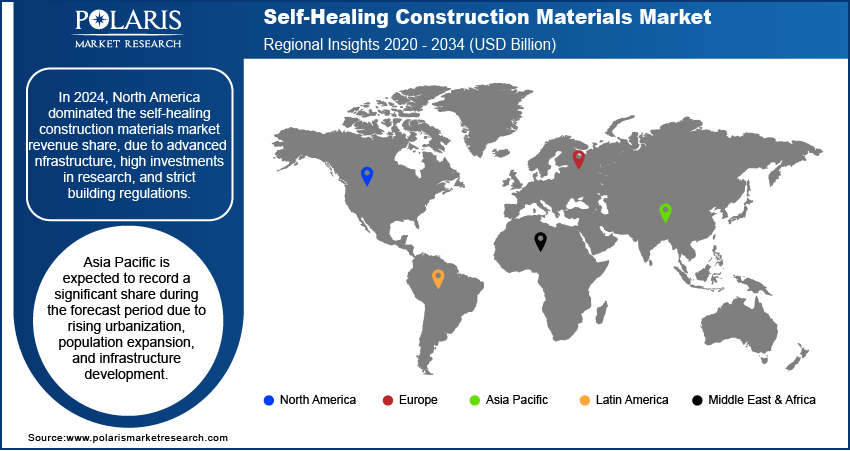
Self-Healing Construction Materials Market Size, Share, Trends, Industry Analysis Report: By Material Type (Concrete, Asphalt, Polymers, and Other), Technology, Application, and Region (North America, Europe, Asia Pacific, Latin America, and Middle East & Africa) – Market Forecast, 2025–2034
- Published Date:Apr-2025
- Pages: 125
- Format: PDF
- Report ID: PM5456
- Base Year: 2024
- Historical Data: 2020-2023
Self-Healing Construction Materials Market Overview
The global self-healing construction materials market size was valued at USD 5.75 billion in 2024. The market is projected to grow from USD 6.47 billion in 2025 to USD 19.35 billion by 2034, exhibiting a CAGR of 12.9% during 2025–2034. Self-healing construction materials are advanced materials designed to automatically repair damage, cracks, or wear over time, extending the lifespan of buildings and infrastructure. These materials mimic biological healing processes, reducing maintenance costs and enhancing sustainability.
The cost of repairing and maintaining buildings and infrastructure is rising due to aging structures and frequent wear and tear. Traditional materials develop cracks and damages over time, requiring expensive and time-consuming repairs. Self-healing construction materials significantly reduce maintenance expenses by automatically repairing small damages before they become serious issues. For example, self-healing concrete seals its cracks, preventing costly structural failures. In industries such as transportation, where road and bridge maintenance is crucial, these materials offer long-term savings. Businesses and governments are increasingly investing in self-healing materials to reduce expenses as repair costs continue to rise, thereby driving the growth of the self-healing construction material market demand.

To Understand More About this Research: Request a Free Sample Report
Innovations in material science and nanotechnology are driving the development of highly efficient self-healing materials. Researchers have introduced new techniques such as microencapsulation, bacteria-based healing, and polymer self-repair mechanisms to improve the functionality of these materials. Nanomaterials, such as self-repairing coatings and smart polymers, provide better durability, strength, and adaptability to environmental conditions. These advancements have made self-healing materials more cost-effective and widely applicable in different construction projects, due to which the adoption of self-healing construction materials is rising.
Self-Healing Construction Materials Market Dynamics
Growing Infrastructure Demand
The demand for durable and long-lasting infrastructure is increasing worldwide. Governments and private sectors are investing heavily in roads, bridges, buildings, and public utilities to support economic growth. According to the Indian Ministry of Information and Broadcasting, in India alone, the government invested USD 114.57 billion in infrastructure in 2023, showcasing the growth in government investment. However, traditional construction materials degrade over time, requiring costly repairs and maintenance. The need for innovative materials that reduce maintenance costs and enhance durability continues to drive the adoption of self-healing construction materials as cities expand and infrastructure projects become more ambitious, thereby driving the self-healing construction material market development.
Increasing Population and Urbanization
Global population growth and rapid urbanization are driving the demand for high-quality and long-lasting infrastructure. According to the World Bank Group, 57% of the global population lives in urban areas, showcasing growth in urbanization. The fast-paced expansion of cities requires better roads, residential buildings, commercial spaces, and public utilities. Traditional construction materials fail to meet the long-term durability requirements of modern infrastructure. Additionally, developing countries experiencing large-scale infrastructure projects benefit from these materials as a sustainable and cost-effective solution, thereby driving the self-healing construction material market growth.

Self-Healing Construction Materials Market Segment Analysis
Self-Healing Construction Materials Market Assessment by Material Type
The self-healing construction materials market segmentation, based on material type, includes concrete, asphalt, polymers, and other. The concrete segment is expected to witness significant growth during the forecast period. The increasing demand for durable and long-lasting infrastructure, especially in urban development projects, is driving the adoption of self-healing concrete. Concrete is widely used in buildings, roads, and bridges but is prone to cracking over time. Self-healing concrete, which repairs itself using bacteria, microcapsules, or chemical reactions, helps extend the lifespan of structures while reducing maintenance costs, thereby driving segmental growth.
Self-Healing Construction Materials Market Evaluation by Application
The self-healing construction materials market segmentation, based on application, includes residential, commercial, industrial, and others. The residential segment dominated the self-healing construction materials market share in 2024 due to the rising demand for durable and low-maintenance housing. Homeowners and builders are increasingly adopting self-healing materials to reduce repair costs and improve the lifespan of buildings. These materials help prevent cracks and damage, making homes more resilient to environmental conditions. Growing urbanization, sustainable housing initiatives, and government support for eco-friendly construction are driving the self-healing construction materials market growth for the segment.

Self-Healing Construction Materials Market Regional Analysis
By region, the study provides the self-healing construction materials market insights into North America, Europe, Asia Pacific, Latin America, and the Middle East & Africa. In 2024, North America dominated the self-healing construction materials market revenue share due to advanced infrastructure, high investments in research, and strict building regulations. The US and Canada are driving adoption, focusing on sustainable and long-lasting construction solutions. Rising maintenance costs for aging infrastructure, such as bridges and highways, are increasing the demand for self-healing materials. Additionally, the growing emphasis on green building certifications encourages the use of eco-friendly materials. Government initiatives supporting smart cities and innovative construction techniques are further boosting the North America self-healing construction materials market expansion.
Asia Pacific is expected to record a significant share during the forecast period due to rapid urbanization, population expansion, and infrastructure development. Countries such as China, Japan, and South Korea are investing heavily in smart cities and advanced construction technologies. The demand for long-lasting and low-maintenance buildings is rising, driving the adoption of self-healing materials. Government policies promoting sustainable construction further support the Asia Pacific self-healing construction material market expansion.
The self-healing construction materials market in India is experiencing substantial growth driven by rapid urbanization, infrastructure development, and sustainability initiatives. The government’s focus on smart cities, affordable housing, and large-scale infrastructure projects is encouraging the use of advanced materials. The country faces challenges related to frequent repairs and maintenance due to extreme weather conditions and high population density. Self-healing materials offer a cost-effective and long-lasting solution for roads, bridges, and residential buildings. Increased awareness of eco-friendly construction, along with investments in research and innovation, is further propelling the self-healing construction material market growth in India.

Self-Healing Construction Materials Market Key Players & Competitive Analysis Report
The self-healing construction materials market opportunity is constantly evolving, with numerous companies striving to innovate and distinguish themselves. Leading global corporations dominate the market by leveraging extensive research and development, and advanced techniques. These companies pursue strategic initiatives such as mergers and acquisitions, partnerships, and collaborations to enhance their product offerings and expand into new markets.
New companies are impacting the industry by introducing innovative products to meet the demand of specific sectors. According to the self-healing construction materials market stats, this competitive trend is amplified by continuous progress in product offerings. A few major players in the market includes BASF, Basilisk, Biomason, Epion B.V, Evonik, GCP Applied Technologies Inc, Oscrete Construction Products, Sika AG, and Xypex Chemical Corporation.
Epion Asphalt B.V. is a company that focuses on developing self-healing asphalt technology. Founded by Professor Erik Schlangen from Delft University of Technology and entrepreneur Martin Megalla, the company aims to improve the durability of asphalt pavements. Epion uses induction-healing methods and rejuvenation capsules to address the issue of asphalt disintegration. The induction-healing technology incorporates steel fibers into asphalt, allowing micro-cracks to be repaired through magnetic induction. Additionally, rejuvenation capsules are embedded in the asphalt binder to release a liquid that counteracts bitumen aging and restores its binding capacity. Epion's products include induction-healing solutions for various types of roads, such as expressways and airport runways. They also offer Induction-Aid (I-Aid), a method for repairing potholes using prefabricated asphalt patches with conductive steel particles. These technologies are designed to extend the service life of pavements by reducing the need for frequent repairs. The company guides clients throughout the construction and maintenance process to ensure effective implementation. Epion operates globally, with projects implemented in several locations. For instance, a stretch of self-healing pavement on the A58 expressway in the Netherlands has been in use since 2010. The company has also expanded internationally, including forming a partnership in Japan.
Biomason, founded in 2012 and headquartered in Durham, North Carolina, is a biotechnology company that has developed a unique biocement technology. This technology uses microorganisms to produce calcium carbonate, which binds aggregate materials at ambient temperatures, providing an alternative to traditional Portland cement. The process reduces carbon emissions and energy consumption compared to conventional cement production methods. Biomason's products include biocement used in applications such as Biolith tiles. These tiles are available for architects and construction professionals seeking environmentally friendly materials. The company also works on precast concrete solutions, military infrastructure projects, and marine cement applications. Additionally, Biomason collaborates with the US Department of Defense on various projects, including dust suppression. Biomason operates globally, with installations in North America and Europe. The company expanded its operations by establishing Biomason Denmark ApS in 2022 and opening a biocement factory in Ikast, Denmark, in 2023. Biomason has secured significant funding, including a substantial investment round from investors such as 2150 and Novo Holdings. The company has received recognition for its work in reducing emissions and has partnered with firms such as H&M Group and IBF to advance its commercial goals.
List of Key Companies in Self-Healing Construction Materials Market
- BASF
- Basilisk
- Biomason
- Epion B.V
- Evonik
- GCP Applied Technologies Inc
- Oscrete Construction Products
- Sika AG
- Xypex Chemical Corporation
Self-Healing Construction Materials Market Segmentation
By Material Type Outlook (Revenue USD Billion, 2020–2034)
- Concrete
- Asphalt
- Polymers
- Other
By Technology Outlook (Revenue USD Billion, 2020–2034)
- Microencapsulation
- Vascular Systems
- Shape Memory Materials
- Bacteria-Based Self-Healing
- Others
By Application Outlook (Revenue USD Billion, 2020–2034)
- Residential
- Commercial
- Industrial
- Others
By Regional Outlook (Revenue USD Billion, 2020–2034)
- North America
- US
- Canada
- Europe
- Germany
- France
- UK
- Italy
- Spain
- Netherlands
- Russia
- Rest of Europe
- Asia Pacific
- China
- Japan
- India
- Malaysia
- South Korea
- Indonesia
- Australia
- Rest of Asia Pacific
- Middle East & Africa
- Saudi Arabia
- UAE
- Israel
- South Africa
- Rest of Middle East & Africa
- Latin America
- Mexico
- Brazil
- Argentina
- Rest of Latin America
Self-Healing Construction Materials Market Report Scope
|
Report Attributes |
Details |
|
Market Size Value in 2024 |
USD 5.75 billion |
|
Market Size Value in 2025 |
USD 6.47 billion |
|
Revenue Forecast in 2034 |
USD 19.35 billion |
|
CAGR |
12.9% from 2025 to 2034 |
|
Base Year |
2024 |
|
Historical Data |
2020–2023 |
|
Forecast Period |
2025–2034 |
|
Quantitative Units |
Revenue in USD billion and CAGR from 2025 to 2034 |
|
Report Coverage |
Revenue Forecast, Market Competitive Landscape, Growth Factors, and Trends |
|
Segments Covered |
|
|
Regional Scope |
|
|
Competitive Landscape |
|
|
Report Format |
|
|
Customization |
Report customization as per your requirements with respect to countries, regions, and segmentation. |
FAQ's
The self-healing construction materials market size was valued at USD 5.75 billion in 2024 and is projected to grow to USD 19.35 billion by 2034.
The global market is projected to register a CAGR of 12.9% during the forecast period.
North America held the largest share of the global market in 2024.
A few key players in the market are BASF, Basilisk, Biomason, Epion B.V, Evonik, GCP Applied Technologies Inc, Oscrete Construction Products, Sika AG, and Xypex Chemical Corporation.
The residential segment dominated the self-healing construction materials market in 2024, due to the rising demand for durable and low-maintenance housing.
The concrete segment is expected to witness significant growth during the forecast period. The increasing demand for durable and long-lasting infrastructure, especially in urban development projects, is driving the adoption of self-healing concrete.
